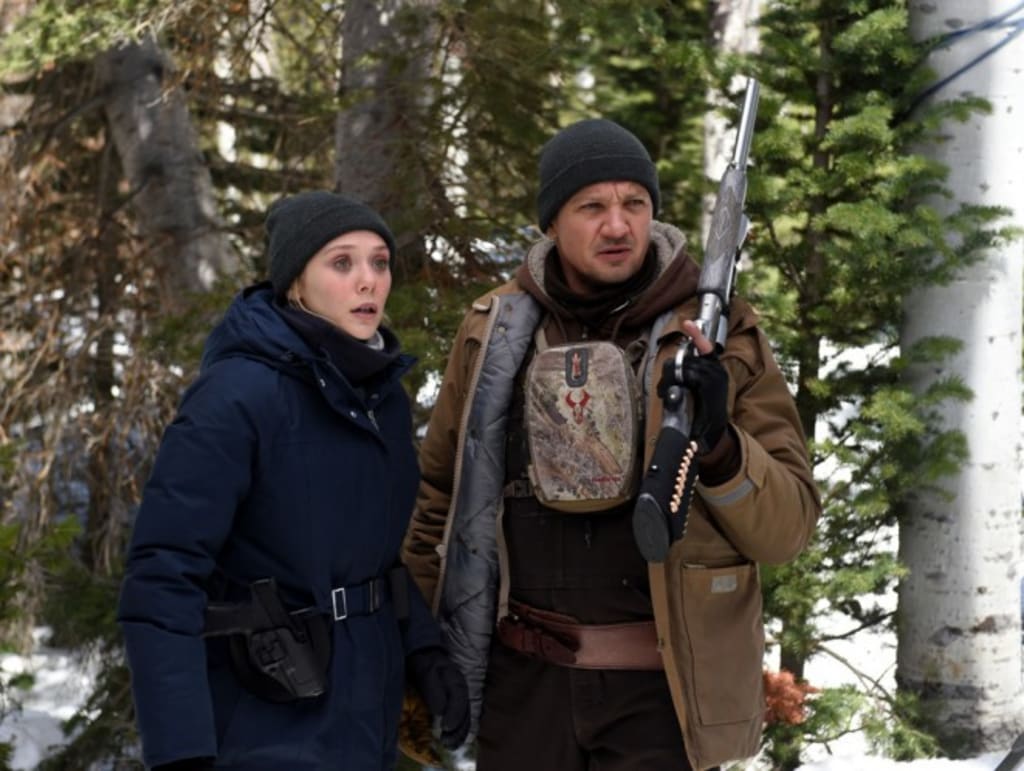Movie Review: Wind River
Powerful Wind River shines a shameful light on our treatment of Native Americans.

Wind River is one of the most emotional experiences I have had at the movies in 2017. The modern western from writer-director Taylor Sheridan is a cold and harsh drama about a cold and harsh place where these characters don’t merely live, they survive. The film also shines a devastating light on the plight of Native Americans and the criminal lack of care we give to their living conditions and well-being. That it takes a white writer-director and two white movie stars to get this story told says nearly as much as the movie itself.
Wind River begins terrifyingly with a young Native American woman running through a barren, snow covered valley. You can feel the cold simply from her manner and the way Sheridan films her running at a distance. Upon closer look your fear for her amps up as it is revealed that she is not wearing shoes or gloves. She collapses and tries to get up and keep going, she’s bleeding. The scene fades to black with her running toward a forest on a mountainside.
The body of the young girl, Natalie, is found a day later by Corey (Jeremy Renner), a hunter employed by the US Fish and Wildlife Administration as he is tracking mountain lions that have been attacking livestock. Corey knows the young girl and her family, they live on the reservation where he met his now ex-wife (Q’Orianka Kilcher). The dead girl was a friend of Corey’s late daughter.
Since the death happened on an Indian Reservation, the jurisdiction is murky, somewhere between County Sheriff’s, the Bureau of Indian Affairs, and the FBI. The FBI is represented by Jane Banner (Elizabeth Olson), an inexperienced agent from Las Vegas who is ill-prepared for the frozen conditions of Utah; she is somehow the closest available agent for the job despite being stationed nearly 400 miles away.
That detail about where Olson’s FBI agent comes from is important as it is indicative of the way crime on Indian Reservations are undervalued and underserved. The film ends with a devastating statistic that is so egregious that it takes the film’s already devastating ending to another level. I was so angry at the revealing statistic at the end of Wind River that I wanted to scream and suddenly, ever so briefly, I came to understand the anger and frustration of these characters so much more.
Wind River is both a work of art and a work of activism. On the art side, writer-director Taylor Sheridan accomplishes something very similar to his incredible work on Hell or High Water. Sheridan crafts characters of extraordinary depth, characters we come to care about and identify with even as they challenge our perceptions about right and wrong and the thin line between what is legal and what is just. With Wind River and his script for Hell or High Water, Taylor Sheridan is establishing himself as a voice of the economically disadvantaged and all of the complexity and hardship that comes from not being financially capable of keeping a family safe, happy and together.
On top of the powerful storytelling, Sheridan gets remarkable performances from Jeremy Renner, Elizabeth Olson, and an emotionally wrenching performance from Hell or High Water supporting player Gil Birmingham that could earn some Academy Award attention. Birmingham’s final scene in the film is weighty and heart-wrenching and may leave many audience members in full-on tears. That is if you aren’t already in tears from Elizabeth Olson’s final moment in the film which includes a single line of dialogue that strikes you right in the heart.
While Wind River is filled with extraordinary emotion, I should also mention that is filled with a great deal of perfectly rendered tension and suspense. While it’s not in the foreground, the moments when Wind River builds toward violence are sharply drawn and impactful. For a first-time director, Sheridan demonstrates tremendous skill in crafting grounded yet exciting action beats that enhance and enrich the films remarkable emotional core.
Wind River ranks alongside the best films of 2017. It’s a powerhouse of emotion with strong action scenes, exceptional performances by the entire cast, including Jeremy Renner’s quietly powerful star turn. What it also does, however, is remind us of a significant problem we have with our relationship with Native Americans. When it requires a white director and two white stars to tell a story about the horrendous conditions in which many Native Americans live in America in 2017 it creates a feeling of shame that I have not been able to shake since I saw the film.
I am ashamed of our historic treatment of Native Americans. I am ashamed of the way we’ve rewritten history to treat ourselves like heroes for taking this country from them violently and acting as if it was some heroic act. I am ashamed of the way we’ve continued to treat Native Americans since we took this country and the ugly narrative that somehow a few Native Americans owning casinos makes up for what we’ve done and continue to do. The devastating, horrifying, and inhuman statistic that closes Wind River is a shame I will never shake. It’s one that will drive me to write members of Congress and do what little I can to reckon for what we’ve done. What we’ve all allowed to happen in this country.
About the Creator
Sean Patrick
Hello, my name is Sean Patrick He/Him, and I am a film critic and podcast host for the I Hate Critics Movie Review Podcast I am a voting member of the Critics Choice Association, the group behind the annual Critics Choice Awards.






Comments
There are no comments for this story
Be the first to respond and start the conversation.